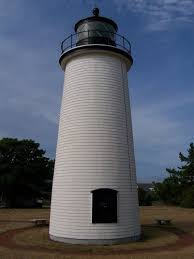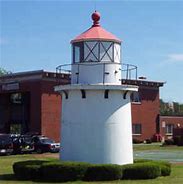


Newburyport is one of Massachusetts’ smallest cities. In the eighteenth and nineteenth centuries, this city was a center for shipbuilding and maritime trade along the Merrimack River. It became a major center for trade from Europe, the West Indies, and China.
During the Colonial period, fires were set on Plum Island’s beaches to aid mariners due to the dangerous shifting of the currents at the mouth of the river.
In 1783, the Marine Society of Newburyport built two day beacons as range lights and employed locals to hoist lanterns on top of them each night. Later in 1788, two wooden lighthouses known as the Newburyport Harbor Lights were built on a barrier island that shadows the Massachusetts’ shore for nearly nine miles, between the mouth of the Merrimack River in the north, and the Ipswich River in the South known as Plum Island.
Built by the locals it provided more needed help for Mariners. These original two towers were built on movable foundations so their positions could be changed easily as the sandbars around Plum Island shifted. Mariners knew that if the lights lined up then they were following the best route to enter the harbor.
Brutal weather often posed a hazard for these lighthouses and its keepers especially in 1808 when both towers were blown over. In December 1839 alone, three storms destroyed over 300 vessels and nearly washed away one of the towers.
In 1873 it came apparent for vessels entering the harbor two miles up the river that another set of range lights were needed to help the mariners navigate near the waterfront of Newburyport Harbor where a dangerous reef known as “Goose Rocks” or “Half Tide”. This was when The Newburyport Harbor Range Station was built.
The front light is on an iron tower, conical in form, 14 feet six inches high, located on Bayley’s new wharf. The focal plane is 25 feet above sea level. The rear light is about 350 feet from the front light, on a brick tower, pyramidal in form, 32 feet high, and the focal plane is 47 feet above sea level. By 1901 the front light had been altered when a shingled, hexagonal wooden section was added to the top of the cast iron tower. This changed the height of the tower to 35 feet high. It was also about this time that the rear tower was raised to 53 feet high.
These range lights were discontinued in 1961 and by 1964 the Front Range tower was relocated to a short distance to the grounds of the US Coast Guard Station on Water Street.
After the Front Range light was destroyed by fire it was changed back to a more traditional appearance with the restoration of its original iron lantern in 1990.
In 2009 the Rear Range tower received a new exterior paint job and a complete interior makeover of the “Lantern Room”. As of the day it is maintained by the Lighthouse Preservation Society and awaits those willing to donate in upwards to $350.00 to support lighthouse preservation and negotiate steep steps and a metal rung ladder, can enjoy six hours of marvelous views from the “Lantern Room” and fine dining from 2 to 4 persons catered by their choice of 5 local restaurants with advance reservations.
Still located on Plum Island the Harbor Range Light was designated as a historical lighthouse in 1981 and today still functions as a single, green, fully automated, 4000 candle power, Fourth Order Fresnel light. It is visible 12 miles off the shore line and is a familiar beacon to mariners along our coast. It is currently maintained and operated by the “Friends of Plum Island Light”.
